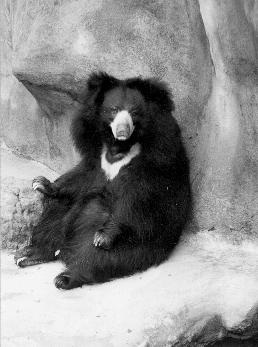![]()

BODY LENGTH:
140-180 cm Tail length: 10-12.5 cm
HEIGHT:
61-91.5 cm
WEIGHT:
55-145 kg
RANGE:
Central Asia, Nepal, India, Sri Lanka
HABITAT:
Moist and dry forests especially in areas of rocky out croppings.
DIET:
Termites, insects, grubs, honey, eggs, carrion, grass, flowers, fruit
BREEDING:
June-August
GESTATION:
6-7 months
LITTER SIZE:
1 or 2, rarely 3
LIFE EXPECTANCY:
40 years in captivity
![]()
The sloth bear has long, shaggy black hair, with the longest hairs being between their shoulders. Usually they are black but cinnamon, and red individuals have been seen. They have a chest mark that is shaped like a "V" or a "Y" and it varies in color from whit to yellow to chestnut brown.
The sloth bear has some very unique structural modifications that give it some unusual talents for feeding. The lips are protrusible, mobile, and bare, the snout is mobile. They can close their nostrils at will and they are missing a pair of upper incisors. This allows them to feed on termites in the following manner: the nest is dug up, the dust and dirt is blown off, and the occupants are sucked up in a "vacuum cleaner" action. The noises made during the sucking, sound like a very loud "Phssst" that can be heard for over 185 meters. Unfortunatly, this often alerts hunters to the bears location.
Sloth bears are active throughout the day but are mainly nocturnal. During cool weather it spends the day in dense vegetation or shallow caves. The sence of smell is well developed, but sight and hearing are relatively poor. Sloth bears do not hibernate.
Vocalizations normally are only heard when they come in conflict with other sloth bears. They include roars, howls, screams, and squeals.
The young of sloth bears leave the den at the age of 2-3 months and often ride on their mothers back. They remain with their mother until they are mostly full grown, possibly 2 or 3 years.
The sloth bear normally is not aggressive but is in held in great
respect by some of the people that inhabit its range. Apparently
because of its poor eyesight and hearing, it is sometimes closely
approached by humans. It may then attack in what it considers to
be self-defense and inflict severe wounds.
![]()